Tuesday, March 30, 2010
How to turn off natural gas
How to Identify an Outside Gas Leak:
* Hissing, roaring or blowing sound
* Dirt being blown into the air
* Water being blown into the air at a pond, river, or creek
* Continuous bubbling in wet, flooded areas
* Fire at or near exposed piping
* Flames apparently emanating from the ground
* Dead or brown vegetation in an otherwise moist or green field
* A “rotten-egg” odor (this is the most common sign inside your home)
Important Reminders:
* The gas company has to come and restart your service if you shut off the gas, so make sure you only do it IF you identify a leak. If there is no leak then it is not necessary to turn off your gas.
* If a gas leak is discovered, turn off any potential “ignition” sources and evacuate everyone from the area
* Do not attempt to make repairs or extinguish fires
Taken from information found in the Questar Gas monthly newsletter
Monday, March 29, 2010
Make your own fabric softener sheets
Suggestions for making your own fabric softener dryer sheets:
* Mix 1 cup liquid fabric softener with 2 cups water in spray bottle. Spray a clean rag or washcloth 4-6 times with the mixture and then put the cloth in with the clothes to dry. Wash the rag occasionally to remove build-up.
* Dip a washcloth in liquid fabric softener, then hand to dry. Once dry, put the washcloth in with the clothes to dry. The washcloth can be used a dozen or so times before needing to be washed and re-dipped. You can make your fabric softener last even longer by dipping the washcloth in a mixture of equal parts water and liquid fabric softener. Or try a different ratio to see what works best for your laundry.
* Take a large jar or bucket, cut a sponge into 4-6 pieces, and place them in the container. Add a few capfuls (if using jar) or one full bottle (if using bucket) of liquid fabric softener, then fill the rest of the way with water. When you go to dry a load of laundry, take out a sponge, ring it out and throw it in the dryer. When done, just put the sponge back in the container for next time! (Tip from PYP member, WtrmlnLisa)
* To control static cling, try adding a wad of aluminum foil to your dryer load.
* If using dryer sheets, cut them in half and use only one half sheet per load. That way a box of 80 sheets automatically becomes a box of 160! (Tip from PYP member, tightwadteri)
Even if you don't want to make your own dryer sheets, you can get extra use out of the commercially packaged ones by using the used sheets to dust around the house or clean bathtubs (they are great for removing soap scum).
Saturday, March 20, 2010
Easter Wheat Grass


How to Grow Easter Grass with Wheat
This is such a fun activity to do with your family. I learned about it at my son’s preschool and knew that I had to post it here for you all to enjoy. Make sure to do it 2-3 weeks before Easter so you can have enough time for your grass to grow! (hint that means you better do it in the next day or two!!!) Hope you have as much fun doing this as we did.
How to Grow Easter Grass With Wheat – Instructions
Step 1: Soak a heaping cup of wheat kernels in a bowl of water overnight.
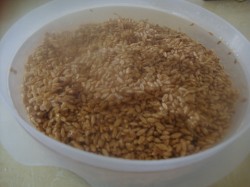
The wheat should have teeny tiny sprouts. Aren’t they cute?

Step 2: Line your Easter basket(s) with saran wrap.
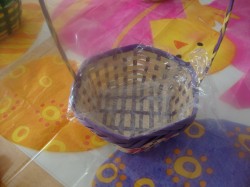
Step 3: Fill the basket with soil

Step 4: Soak the soil with water, get it nice and wet
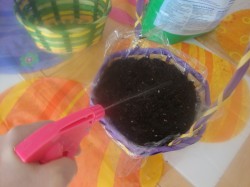
The kids think this part is really fun ![]()

Step 5: Spoon a thick layer of wheat onto of the soil. Mist with a little more water.
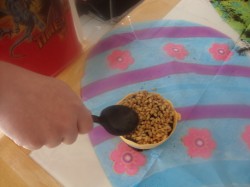
Doesn’t that look so nice?

Step 6: Wrap the basket(s) in plastic or a ziplock bag. Try to make it airtight.
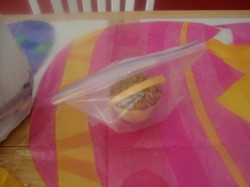
Look how cute our baskets (and kids) are before the plastic.

Step 7: Set in a warm place and leave the plastic on until most of the seeds have started to sprout grass. Remove plastic and mist daily if it looks dry.
Step 8: Enjoy a nice thick blanket of REAL Easter grass in a few weeks!
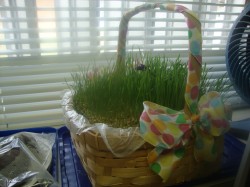
Don’t forget to try to have at least one accident along the way. It makes life exciting ![]()
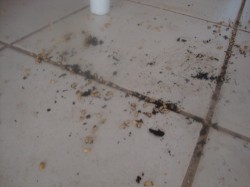
HAVE FUN and HAPPY EASTER!!!

Thursday, March 18, 2010
water storage
Store for Thirst First!
By Angie Sullivan
I felt like I couldn’t last an afternoon without my bottle of water, so how would I fare in an emergency?
 The other day, I spent the afternoon helping at my daughter’s school. I usually carry around a bottle of water with me, but I had forgotten my bottle in the shuffle of bringing in supplies. I came home later that evening and downed a HUGE class of cold water. As hungry as I was, it was the water that I was really yearning for. It was then that I began to think about this new journey of Preparedness I was planning on taking with you, and it struck me that if I could barely go a few hours without getting uncomfortable without water, it should be top on my preparedness priority list!
The other day, I spent the afternoon helping at my daughter’s school. I usually carry around a bottle of water with me, but I had forgotten my bottle in the shuffle of bringing in supplies. I came home later that evening and downed a HUGE class of cold water. As hungry as I was, it was the water that I was really yearning for. It was then that I began to think about this new journey of Preparedness I was planning on taking with you, and it struck me that if I could barely go a few hours without getting uncomfortable without water, it should be top on my preparedness priority list!How long can a human survive without water? Most sources cite that the human body cannot survive without water for longer than 3-4 days without doing damage to bodily organs. Beyond 4 days, all the food in the world would do you no good without water. For this reason, I decided to focus on water storage for our first landmark on our trip to Destination Preparedness!
Emergency Essentials Inc., suggests that the first place I needed to store water was in my 72 hour emergency kits. You remember those! The pack of survival items you need if you had to get up and go with your family. Of course, you can choose to outfit your pack with basic water bottles. They are easy to find at your local grocery store. If you would like something specifically made for long term storage, you can store a metalized water pouch or box. These nifty little containers look a lot like those juice boxes or pouches you’d put in your child’s lunch box. They are specially treated, filled with purified water, and are specifically made for long term storage, just perfect for that emergency kit!
 Now that you have your survival stash for the first three days of an emergency, what about storing water in your home? Did you know that you should consider having both stationary and portable water?
Now that you have your survival stash for the first three days of an emergency, what about storing water in your home? Did you know that you should consider having both stationary and portable water?Boxed water containers and water barrels are the least expensive and most space efficient way of storing large volumes of water.
Portable water is stored in containers of approximately 5 gallons or less (remember 8 pounds per gallon!) These are very helpful to have on hand for transporting your stored water to a usable location, like your car if the emergency requires leaving. Once the water has been used, simply fill up the jug again from your stationary source. Five gallon jugs are a great choice for your portable water storage. You can also use washed out plastic soda pop bottles, but be sure to clean them out well and store them away from light and other storage items that could be damaged should the bottles leak. Do not use milk jugs, they are much more prone to bacterial growth and the plastic breaks down over time. The key to good water storage is to have a clean, sturdy container that protects against light penetration. This key inhibits bacteria growth. One of the best ways to store a portable source of water is a boxed water kit. These kits come with a metalized bag that you fill with water and then place in a sturdy cardboard box. Do you want to know the coolest thing about these kits? In an emergency, the sturdy box can double as an emergency toilet! Love that!
The most common containers for larger amounts of stationary water storage are those blue water barrels you see around. These heavy-duty, thick, polyethylene barrels are made of food grade materials. Barrels made for water are usually blue. Color is important, as blue means water is stored, and red indicates fuel. (Remember those fuel containers for your lawn mower?) Be aware that other colors may not be made of food grade plastic. You can purchase these barrels in many sizes. I’ve found that 55, 30, and 15 gallon are the most common. Try and store your blue barrels in a cool, dark area. A basement is a perfect option. Make sure there is an insulation barrier between the barrel and the ground. I’ve got mine perched upon some wood leftover from a home improvement project. It is not recommended to store your barrel outside, but if it is absolutely necessary, be sure to keep the barrel out of sunlight and be careful not to fill it too high! It is also wise to insulate the barrel and protect it from the elements as much as possible. You need about 1/10 of the barrel empty to allow for expansion should it freeze. This is not ideal, so don’t put it outside unless you have to. Oh, and don’t forget to grab that bung wrench and siphon pump! They are the tools you’ll need to open your barrel and siphon the water out!
So the next question that sprung up in my mind was how much water should I store? I discovered that experts recommend storing a minimum of 14 gallons per person. This is a two week supply if you store the minimum one gallon per person per day suggested for drinking and light sanitation. Light sanitation? I sit here thinking about my own family of five, four of which are females. I can’t imagine this gaggle of girls using just one gallon comfortably. For this reason, I’ve decided we are going to store some extra for our next emergency.
Have we quenched your thirst for knowledge on water storage? I hope so! You are now ready to equip your family with the most necessary of all supplies! WATER!

Saturday, March 6, 2010
The 15 minute 72-hour kit
All to say - what kind of emergency stuff to you have on hand? Here's a partial post from the "Pinching Your Pennies" blog that gives a very basic, 15 minute version of how to put together basic kits for your family that's worth reading:
"...I'm a firm believer in the idea that ANY preparation is better than no preparation at all. So I wanted to find a way to put together a bare-bones, bare-basics kit that wouldn't cost much money and could be thrown together in a matter of a few minutes so that it would be done and ready should the need ever arise.
In an emergency situation, the top priorities are water, wound care and sanitation/hygiene. You can go a few days without food. You can go for weeks without a shower or brushing your teeth or shampooing your hair if you had to (no, it wouldn't be pretty, and it might be downright miserable, but you'd at least survive).
But you CAN'T go for very long without water. And if you happen to get a wound (which is quite likely in an emergency) and it gets infected and is untreated, you just plain WON'T be able to go for very long - period.
With that in mind, I rummaged through my house to come up with the items that I felt were a bare-minimum for an emergency kit. These are kind of the essentials for sustaining or preserving life. Here's what I came up with:

small backpack
sweatshirt/jacket
bottled water [it's not the recommended 3 gallons, but it's certainly better than nothing, and you can add more if space and weight allow]
assorted adhesive bandages
antiseptic wash (or alcohol wipes or iodine)
antibiotic ointment
otc pain relievers
any prescription meds you take on a daily basis
food for 1 day [I just grabbed 6 granola/nut bars - convenient, no cooking required, and could be easily rationed if needed]
bar of soap
washcloth
roll of toilet paper
(for the gals) feminine hygiene products
[If you have a young child, you might want to include a baby blanket, cloth or disposable diaper(s) and possibly a bottle and formula]
It took me about 15 minutes to gather all these items. There was still about 6 inches of room at the top of the backpack, and even with the water bottle included, the entire pack only weighed 5lb 10oz. It was fast, cheap (all items came from around my house already) and lightweight.
Remember, this is not a deluxe version. This is just a quick put-together kit that you can do on the cheap that will get you started. But even this bare-basics kit will still get you a lot farther in an emergency situation than having no kit at all.
Of course, the idea is that you can then add to and customize your kit as time and finances and circumstances allow. There are many more things you might want to add if space and weight will allow. But even if you don't add anything else, at least you'll have something put together should the need ever arise (but hopefully it won't).
Here's a quick list of other things you might want to add on (and this is by no means an exhaustive list):
flashlight
trash bag/rain poncho
copies of important documents (birth certificates, IDs, contact information, etc.)
additional first aid supplies
change of clothes and additional cold weather items (hat, gloves, etc.)
additional personal hygiene items (shampoo, toothpaste, wet wipes, razor, etc.)
knife or survival tool
additional food
whistle
matches
solar blanket
water purification tablets or water filtering device
hand sanitizer
etc."
Stockpiling food as a hedge against inflation?
Some other provident living related sites you might enjoy...
This is what happens when an enterprising woman combines humor, cooking and photography. Entertaining and very informative. Try her apple dumplings - to die for
http://thepioneerwoman.com/cooking/2008/02/apple_dumplings/
And...click on the icons below for some great suggestions of things to make for your family or home on the cheap.









